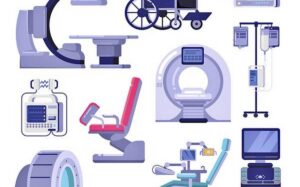The Healthcare industry in India is a broad term, it’s an umbrella term that encompasses various sub-sectors under it. Key sub-sectors under the healthcare industry in India include hospitals which contribute almost 70 percent to the healthcare industry followed by pharmaceuticals which are 13 percent, medical devices 9 percent, medical insurances 3 percent, and diagnostics 4 percent. The market size of the Indian healthcare industry is estimated to be $160 billion and the market is growing at a very fast rate which is around 20-22 percent Compound Annual Growth Rate (CAGR) per year and it is estimated that the healthcare industry in India will reach around $372 billion by 2022.
“Advancement in medical Technology, substantial demand, and ongoing standardization of regulation and accreditation have made India an attractive destination for MNCs to outsource manufacturing of High-End Medical Devices. It is predicted that developments like consolidation, international tie-ups, and demand will aid in delivering world-class products and services“.
Medical Device Sector in India
The medical device market is estimated to be close to $5-5.5 billion in 2016-17 and this sub-sector of the health industry in India is thriving at a rate of 15-30 percent and its estimated growth will continue for the coming decade. In India, it’s a predominantly import-driven market where 75 percent of the market is with imports and domestic manufacturers catering only 25 percent to the market. The domestic manufacturers which are present in India do not have the competencies or sophistication of technology to move up the value chain, it’s mostly taken care of by multinational companies which operate on the model of importing and selling their products into India.
Market Segmentation of Medical Devices Sector India
The key segmentation of medical device market instruments and equipment provides 54 percent to the total $5 billion of the market. Consumables are 26 percent of the market, medical implants and aides contribute almost 20 percent to the market share. In terms of instruments and equipment, it includes imaging, surgical, diagnostics, digital, and other instruments. On the consumable side equipment such as medical textiles, needles, syringes, medical bags, wound care are used by hospitals and hospital infrastructure in their day-to-day utilization. For implants and aids, they are differed by specialties like orthopedic, cardiovascular, neurology, spinal, dental, urology, and more.
85 percent of these equipments and instruments are imported in India and only 15 percent of products are domestically manufactured. The second-biggest category in terms of import dependency is the medical implants which are 75 percent imports and 25 percent domestic but for consumables, it’s little different, 60 percent is with the domestic manufacturer and 40 percent of the market is imported because consumables are usually manufactured in India as they have the capabilities, competencies, and technology.

Pic Credits: Business Line
Key Growth Drivers
- Riding the Expansion Wave: Proposed public and private investments in healthcare facilities offer opportunities for suppliers and manufacturers of hospital equipment that accounts for 40-50% of the costs of setting up a hospital. There is also increasing demand for refurbished sophisticated equipment from smaller hospitals and laboratories.
- Untapped Tier 2 and 3 markets: Healthcare services in these untapped markets have a huge demand-supply gap, enabling companies to address the need for both primary care and super-specialty tertiary care. This results in investment opportunities in both infrastructure (clinics and hospitals, among others) and medical device solutions.
- FDI: 100% FDI allowed through automatic route.
- Government Schemes: Government initiatives such as health insurance, Make in India and PPP initiatives provide opportunities for foreign players.
- Increased affordability due to growing income.
- An Increase in number of ailments.
- Increasing demand due to “Medical tourism”.
Key Challenges
- Low Penetration – The per capita medical device spending of USD 3, compared to USD 7 in China and USD 42 in Russia is significantly low.
- Lack of Accessibility – The Indian healthcare system is inadequate, inefficient, and unevenly distributed. 69% of the Indian population lives in rural areas while 73% of qualified consulting doctors reside in urban areas. 8% of qualified doctors are in rural areas, and the remaining 19% are in semi-rural areas.
- Inadequate regulatory systems: Non-alignment with global standards and the lack of quality product testing infrastructure are issues that hinder sectoral progress.
- Pricing environment, unavailability of skilled resources.
Key Opportunities
- Setting up R&D centers in India, medical device testing facilities.
- Exploring opportunities like providing maintenance services to the Indian end-users.
- Human resource development in terms of training and up-gradation of skills.
- Direct imports and selling of medical devices in the Indian market.
- Considering India as an opportunity for manufacturing contract manufacturing.
- Indian manufacturers are looking to move up the value chain, the U.S. companies can provide technical knowledge and design support.
Market Entry Options
Greenfield entry, brownfield entry strategic alliances are the key options. International medical device companies are looking to explore the Indian market and may initially need a distributor to market their products, whereas some companies intend to take advantage of low-cost manufacturing to export to other neighboring countries. Major export markets may set up and acquire a manufacturing plant in India. New entrants or smaller players may initially prefer entering into alliances with domestic companies and gradually scale up whereas mature larger players may opt to enter directly through brownfield or greenfield investments.
How do I start a medical business?
Science and technology is a game-changer and has propelled the efficiency and dependability of medical devices. The primacy of medical devices and equipment to the vitality of a patient alongside the directly developing technology raises the bar for medical device companies. Like any other business, getting the right matrix of factors and steps can help start and run a medical device company successfully.
Building Opportunity In The Midst Of Crisis: Indian Startups Making Millions In The Pandemic
- Knowing the functioning of medical devices can determine the future of a patient. That is the reason why strict legislation is imposed on medical device companies. One has to stay on the steady perspective of legal bodies by guaranteeing companies certification by both the FDA and International regulatory agencies.
- If a medical device idea is unique, then one has to protect intellectual property. Safeguarding ideas, name of the brand, processes, and logos, through patents or trademarks. The objective of protecting intellectual property is that it assures the sales of unique products that no other company can produce. This gives the company a competitive edge in the market and a chance to grow enormously.
- To stand out in the market, one will require to manufacture the best products. Producing quality products is also the only way to make sales and stay profitable but it is also about ensuring to consult with respective experts to get the best products to the consumer.
- Knowing the size of your customers is key to avert cases of being subjugated by customer requests. Taking the time and understanding the preexisting market demands, population, target customers, including the cost of healthcare systems and the likes will help in the long run.
- Money is essential in starting up and running a startup. Initially, one will require sufficient funds to establish the base of the medical device startup. Establishing a key funding strategy that doesn’t stretch will help in future endeavors.
Also Read:
- NGOs & Civil Society Support Crucial For India’s Recovery From Covid-19 Pandemic
- COVID-19 Variant Omicron- A New Cause Of Concern
- Coworking Spaces: A New Normal Post Covid-19
- Covid-19 Changing The Face Of Healthcare In India
- Impact Of COVID-19 On Early Childcare And Education
- Displaying Courage And Resilience: Women Combatting Covid-19
- Technology Innovations During Covid-19: Utilising The Digital Space
- Health And Hygiene- To Triumph Over Covid-19
- How Is The New Strain Of Covid-19 Impacting The World?
- Crumbling Banking Sector: Impact Of Covid-19




